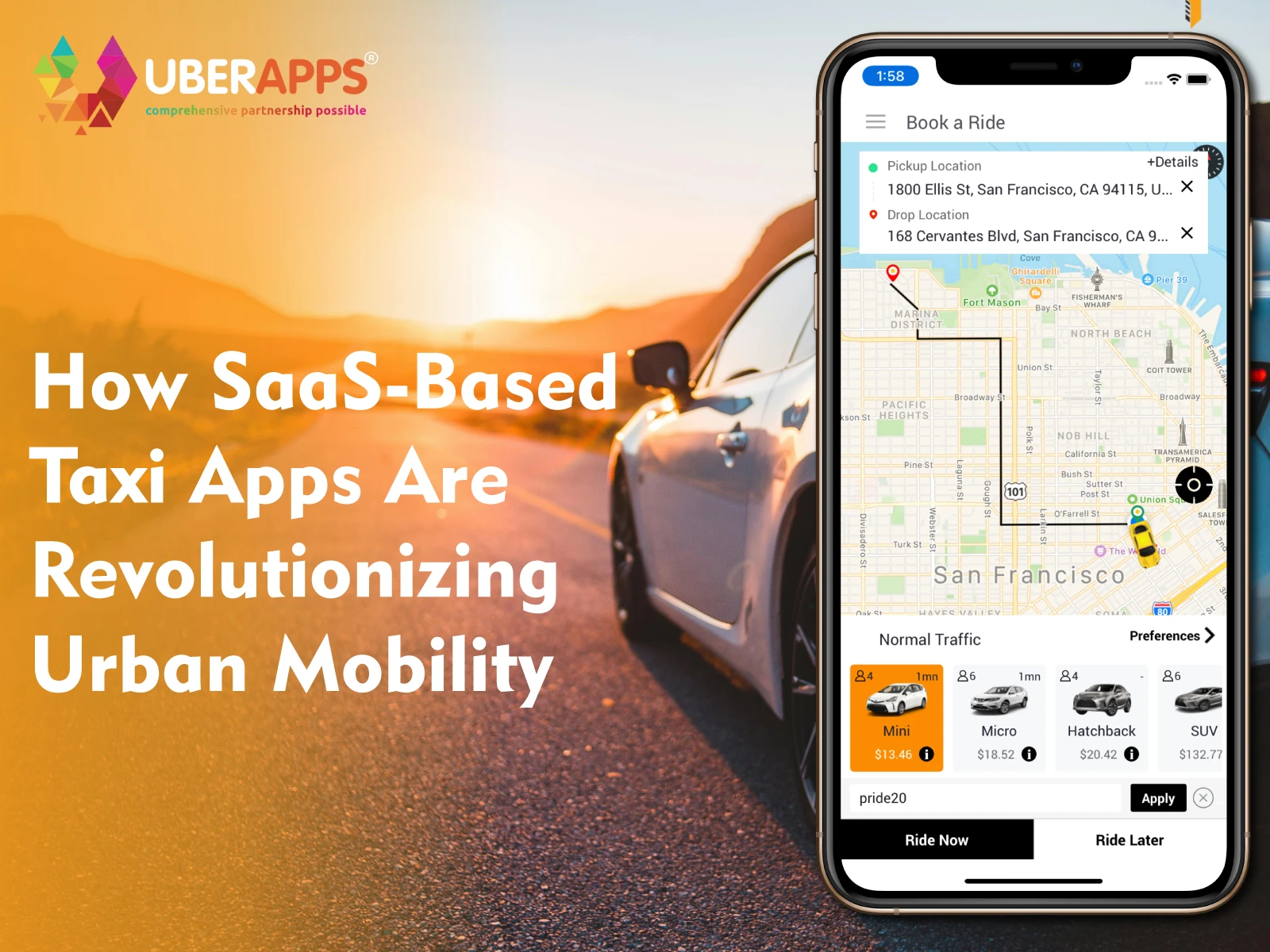
How SaaS-Based Taxi Apps Are Revolutionizing Urban Mobility
In the era of smartphones and smart cities, urban mobility is undergoing a major transformation. Traditional taxi systems are struggling to keep up with expectations of convenience, transparency and cost. Meanwhile, SaaS-based taxi apps have emerged as a compelling solution. In this article we’ll explore how Software-as-a-Service (SaaS) models, taxi booking apps, Uber clone platforms and in-app payments are reshaping how people move in cities.
As cities push toward greener transportation, SaaS-based taxi apps are transforming how fleets operate. Instead of relying on manual dispatch and inefficient routing, modern AI-powered taxi booking apps optimize every mile cutting fuel use, idle time, and emissions. Through cloud automation, real-time analytics, and smart algorithms, ride-hailing companies now achieve both profitability and sustainability. This blog explores how SaaS taxi app platforms are enabling eco-friendly operations—from predictive fleet scheduling and EV adoption to driver behavior insights and carbon-tracking dashboards. Whether you’re a startup or an established operator, you’ll see how embracing SaaS taxi app development can future-proof your business and align it with global sustainability goals.
Defining the SaaS Model
SaaS means a software product is hosted in the cloud and offered on a subscription basis, rather than built from scratch in-house.
For taxi businesses, this means operators subscribe to a ready-made platform instead of developing an app from the ground up.
The operator gets the passenger app, driver app, admin panel and dispatch engine all set up and maintained by the SaaS provider.
Why It Matters for Taxi Booking Apps and Uber Clone Solutions
With a SaaS-based taxi app, startups or fleet owners can launch much faster and at lower cost.
It becomes feasible to compete with large ride-hailing platforms by using an Uber clone style app that is white-labeled and launch-ready.
The result: urban mobility services become more accessible and localised, rather than dominated by a handful of major players.
Key Features of Modern Taxi Booking Apps
Ride-Hailing App Features That Matter
Real-Time Vehicle Tracking & Dispatch
Passengers can see the driver’s location, estimated arrival time and earn trust.
Drivers get optimised routes, reducing idle time and increasing earnings.
Automated Dispatch & Surge Handling
The system automatically allocates the closest driver, balancing demand and supply.
Surge pricing or dynamic pricing can be enabled during peak periods.
Driver Dashboard & Fleet Analytics
Drivers see their earnings, trips, ratings and performance.
Operators get analytics on revenue, usage, hotspots and fleet utilisation.
In-App Payments for Taxi Apps
Easy payment via card, wallet, UPI, even BNPL or cryptocurrency in some markets.
Seamless experience reduces friction, increases trust and provides transparent billing.
White-Label Branding and Customisation
Operators can brand the app under their own name (“Uber clone” style) even though it’s a SaaS platform.
Multi-language, multi-currency and localisation add to flexibility.
Advantages for Urban Mobility
- Lower upfront cost: No need to build huge systems from scratch.
- Faster time to market: Launch in weeks rather than months.
- Scalable and flexible: Can expand fleet, cities or add features with minimal extra infrastructure.
- Better passenger experience: Greater convenience, trust and transparency.
- Supporting smart cities: Integration with EVs, shared mobility, public transport.
How SaaS Taxi Apps Are Transforming Urban Mobility
The Shift From Traditional Taxi Systems
Traditional taxi services often relied on manual dispatch, phone calls, and cash payments.
They lacked data analytics, dynamic routing, real-time tracking and app convenience.
SaaS taxi apps bring all of these into one platform, increasing efficiency, reducing wait times and improving service quality.
Impact on Passengers, Drivers and Operators
For Passengers
Instant booking, transparent fare, route tracking and digital receipts.
More trust, fewer surprises.
For Drivers
Better utilisation, less idle time, fairer ride allocation, higher earnings potential.
For Operators and Fleet Owners
Cloud-based backend, analytics dashboard, lower IT overhead, and ability to scale.
SaaS means maintenance, updates and infrastructure are handled by the provider.
Urban Mobility and Smart City Integration
SaaS taxi apps are not just about trips; they fit into the broader urban mobility ecosystem (MaaS – Mobility as a Service).
They support EV integration, multi-modal transport (taxi + bike + bus), congestion reduction and smarter routing.
Cities can leverage SaaS taxi apps to cut carbon emissions and improve traffic flow.
Taxi App Development: Launching Your Own Uber Clone Platform
Choosing the Right SaaS Provider
- White-label solutions: Support your brand identity.
- Comprehensive platform: Passenger app, driver app, admin panel, dispatch engine, payment integration.
- Internationalisation: Verify localisation features for scaling.
- Security and compliance: Ensure data protection and uptime reliability.
Minimum Viable Features to Get Started
- Booking screen: Pickup/drop-off management.
- Real-time map/tracking.
- Driver app: Accept/decline rides, navigation.
- Payment system: In-app digital payments.
- Admin dashboard: Monitor rides, drivers, revenue.
- Iterative development: Launch fast, gather feedback, improve.
Steps for Taxi App Launch
- Market research & demand analysis: Understand your city’s mobility gap.
- Select SaaS platform: Choose a provider and customise branding.
- Configure features & payments: Decide payment gateways, ride types, pricing.
- Pilot launch: Start in one zone, gather feedback.
- Full rollout & scaling: Expand across regions, add drivers, marketing.
- Continuous improvement: Use analytics for refinement.
Best Practices & Tips for Success in the Taxi App Space
Focus on Localisation
Recognise regional differences in payment methods, smartphone penetration and rider expectations.
Adapt for language, currency, cultural preferences.
Prioritise Safety and Trust
Driver verification, real-time tracking, SOS button, ratings system.
Transparent fare calculation and in-app receipts build trust.
Offer Multiple Payment Options
Credit/debit card, wallets, UPI, cash fallback (especially in emerging markets).
Smooth in-app payments = fewer barriers to ride.
Use Data to Optimize Operations
Monitor peak hours, demand hotspots, driver idle time.
Use analytics to adjust driver allocation, surge pricing and incentives.
Plan for Scalability Early
Choose a SaaS platform that handles spikes in demand and supports multiple cities.
Ensure flexibility for adding features like ride-sharing and EV support.
Market Smartly
Emphasise convenience, speed, reliability.
Incentivise early riders and drivers.
Leverage local partnerships (hotels, events) to drive bookings.
Challenges & Considerations in SaaS Taxi App Deployment
Regulatory & Compliance Issues
Ride-hailing faces regulation in many cities (licensing, insurance, labour laws).
Ensure your taxi app development platform supports necessary compliance.
Connectivity & Infrastructure Gaps
In some emerging markets, smartphone or internet coverage may be inconsistent.
Provide fallback (SMS booking, offline mode) where necessary.
Competition & Differentiation
The taxi booking app space is crowded; you’ll need a unique value proposition (e.g., niche service, local branding, special subscription models).
Data Privacy & Security
Passenger and driver data must be protected; encryption, secure cloud hosting and compliance with regulations (GDPR, etc.).
The Future of Taxi Apps and Urban Mobility
Electric Vehicles & Green Mobility
SaaS taxi apps are increasingly integrating EV-support, carbon footprint tracking and sustainability metrics.
Urban mobility strategies are shifting toward low-emission transport and shared services.
Multi-Modal Mobility and MaaS
The future is not just taxis it’s an ecosystem: ride-hail + micro-mobility (bikes, scooters) + public transport all under one umbrella.
SaaS taxi apps will play a role in linking these modes, offering seamless journeys.
AI, Predictive Analytics & Autonomous Vehicles
AI-driven ride allocation, demand forecasting and route optimisation are becoming mainstream.
Eventually, autonomous taxis (robotaxis) may plug into these platforms.
Key takeaway: SaaS-based taxi apps empower rapid launch, scalable operations and seamless passenger experiences making them a cornerstone of modern urban mobility.
Conclusion
The urban mobility landscape is changing fast, and SaaS-based taxi apps are at the heart of that transformation. By offering operators a subscription-based, white-label Uber clone style solution, taxi companies and new entrants alike can launch quickly, scale efficiently and deliver a high-quality experience. Key features real-time tracking, in-app payments, driver dashboards, analytics enable smoother operations and smarter decisions. For passengers, this means faster bookings, reliable rides and transparent pricing. For cities, it means more efficient transport networks, improved sustainability and integration with other mobility modes.
As mobility continues to evolve with electric vehicles, shared micro-mobility and AI-powered dispatch, taxi apps built on SaaS platforms will only become more central. For entrepreneurs and fleet owners, the message is clear: to succeed in the race for urban mobility dominance, you must embrace a scalable, tech-driven platform and SaaS taxi apps provide exactly that. Whether you’re starting in one neighbourhood or planning a city-wide mobility service, adopting the right taxi app development strategy will give you the agility, cost-efficiency and future-readiness you need.
FAQS
1. What exactly is a SaaS taxi app?
A SaaS taxi app is a cloud-hosted, subscription-based taxi booking platform where an operator uses a ready-made solution (passenger app, driver app, dispatch engine) rather than building from scratch.
2. Can I use a SaaS taxi app as an Uber clone for my city?
Yes — many SaaS platforms are white-label and allow you to brand the app as your own, essentially replicating an Uber clone model tailored to your market.
3. What are the must-have features of a modern taxi booking app?
Essential features include real-time vehicle tracking, automated dispatch, in-app payments, driver dashboards, passenger ratings, and analytics for operators.
4. How does in-app payment integration benefit a taxi app?
In-app payments remove friction from the ride experience, provide instant digital receipts, offer multiple payment methods and improve trust between passengers and drivers.
5. What challenges should I be aware of when launching a taxi app?
Key challenges include regulatory compliance, data security, connectivity issues in some markets, competition and differentiation, and choosing a provider that supports scalability and localisation.
Author's Bio

Vinay Jain is the Founder of UBERApps and brings over 10 years of entrepreneurial experience. His focus revolves around software & business development and customer satisfaction.

